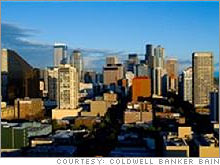 |
| View from a Seattle high rise. |
|
|
|
|
|
New York (CNN/Money) -
Western U.S. cities, once bastions of low rise construction and single-family homes, are beginning to embrace their inner Manhattans: loft apartments and high-rise condos are springing up in downtowns from Seattle to Austin.
Many of these places once had little in the way of a town core. Unlike eastern cities, which developed with well-defined business districts near tightly packed residential neighborhoods, western towns came of age during the automobile era and tend to sprawl. The suburb was king.
A place like downtown Sacramento, for example, "had never been a place to go and certainly not to live," says Jeff Culbertson, senior vice president of Coldwell Banker Residential, a brokerage that serves northern California.
That is all changing. Vertical development has come to California's capitol -- and the residents are loving it. This year a high rise condo erected near the center of Sacramento sold out 250 condos the first day.
"That's something that would never have happened three or four years ago," says Culbertson.
Cities have become chic again and urban centers like New York, Boston, Chicago, and San Francisco are being emulated rather than shunned.
Phoenix, says Bill Jilbert, president and CEO of Coldwell Banker Brokerages, is seeing more vertical development than ever.
In Seattle, J. Lennox Scott, chairman and CEO of JL Scott Real Estate, says, "Hige-rise condominiums are becoming the new housing supply."
The trend is transforming cities. A generation ago, you didn't go to downtown San Jose without an armed guard, according to Culbertson. That turned around beginning in the early 1980s, he says, when redevelopment geared to higher densities took off.
Density brings energy to downtowns, says Scott. It revitalizes neighborhoods and cause cafes, clubs, galleries, and boutiques to spring up to serve the increased populations. More people make downtowns safer, more vibrant, and fun.
Cost counts
But is it just a matter of wanting to be where the action is that has caused downtowns out west to flourish? No, according to Culbertson.
He says, "People will always prefer a single-family home. Condo popularity is more tied to price." Many buyers, especially the young, have been priced out of the single-family-home market. In his territory of northern California, only about 15 percent to 20 percent of the residents could actually afford the median single family home there, based on their incomes.
Condos offer entry-level buyers a chance to get into the housing market. In Silicon Valley, the median price of a single-family home has reached $714,000, according to DataQuick Information Systems. The median condo there sells for $490,000, more than 30 percent less.
It's similar in the city of Phoenix, where the median house sells for $154,000 and the median condo just $112,000, according to the Arizona Real Estate Center. In almost all markets, condos are less expensive than single-family homes.
Still smoking
All those prices are still on the upswing, according to the latest figures from the National Association of Realtors, and the West leads U.S. regions both in median prices and in appreciation.
The median home price in the West is now $322,000, compared with the national median of $220,000. They rose 20.1 percent over the last 12 months compared with 15.8 percent nationally.
Brokers report, however, that in many local markets, conditions have slowed slightly in the last few months.
Culbertson calls San Francisco still red hot, but reports that the market has cooled a bit from a year or so ago. But bay-area satellite cities have skimmed off some of The City's excess demand and prices have risen steeply in some formerly inexpensive areas. In Oakland, for instance, housing price have risen 23 percent to 27 percent for the last few years.
The Phoenix market has had a slight drop off, according to Jilbert. "We're seeing more inventory build the last three months," he says. "There's less of a frenzy when a property comes on the market. We're not seeing 20 offers the first day."
It would not necessarily be a bad thing if these cities cool a touch. The hotter the market, the more likely it is to blow.
But in the meantime, western cities will continue their transformation into more urban lifestyles. Population growth helps fuel the trend. The Census Bureau reports that the region's population increased by 5.5 percent during the period from April 1, 2000 through July 31, 2003, more than any other U.S. region.
Many newcomers to the West will settle in cities and others making the switch from suburb to city will join them. Today, said Culbertson, "People in suburbs want to move downtown."
____________________________
Have a good networking story to tell? For an upcoming feature in Money magazine, we are looking to speak with people who have landed a new job (or helped someone else find one) through creative networking. E-mail cweisser@moneymail.com.
For a story on market trends back east, click here.
Most city housing prices are not out of whack. Click here for that story

|